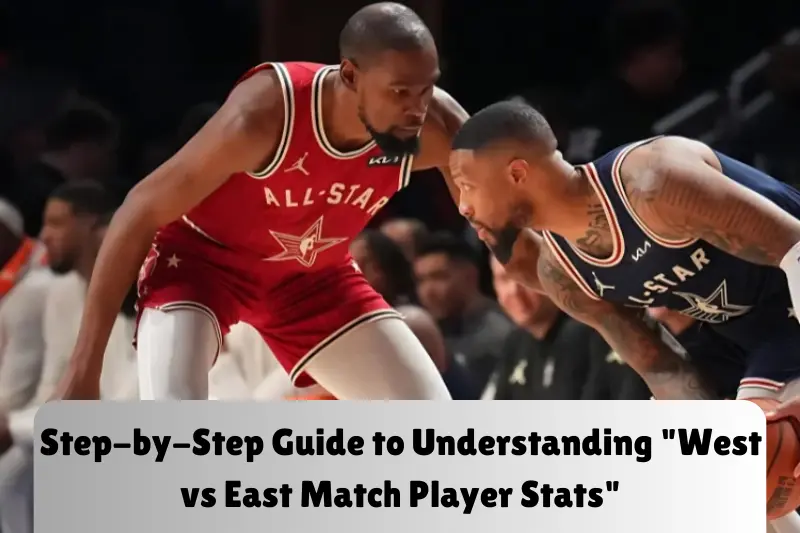Introduction
In the world of sports, the West vs East Match Player Stats rivalry is one of the most exciting matchups, bringing intense competition between teams or players from the Western and Eastern sides of leagues. Fans eagerly watch these games, and one of the most talked-about aspects is the player stats that come out of these showdowns. From scoring points to defensive plays, each stat helps tell the story of a player’s performance and impact on the game.
At Kongotech.org, we dive deep into these stats to bring you a closer look at what they reveal about players from each side. Whether it’s a basketball game, a soccer match, or any other sport, tracking player stats in “West vs. East” matches lets fans and analysts see how top players stack up and how team strengths and individual skills measure up. In this article, we’ll break down key player stats, spotlight some of the top performers, and highlight trends from recent seasons to show you why these matchups are always so thrilling.
What is “West vs East Match Player Stats”?

“West vs East Match Player Stats” refers to the detailed performance metrics of players in games where teams from the Western and Eastern regions compete. These stats capture the players’ achievements in each game, from points scored and assists made to defensive plays like rebounds, steals, and blocks. By analyzing these statistics, fans, coaches, and analysts can get a clear picture of how players contribute to their teams during these high-stakes matchups.
In many sports leagues, especially in basketball, the rivalry between Western and Eastern conferences creates excitement as top players from each side face off. “West vs East Match Player Stats” show how well players perform, highlighting who scores the most points, who dominates defensively, and who leads in teamwork through assists. These stats are not just numbers—they tell the story of each game and reflect the strengths and skills that each player brings to the matchup. At Kongotech.org, we explore these stats to provide fans with a deeper understanding of the game and the players they admire.
You May Also Like It
Trendzguruji.me – Computer, Cyber, Awareness, SEO, Health & Beauty Guide
TrendzGuruji.me Cyber Insights Hub
“What’s Up with Emerald Gems? Let’s Talk
Why Are “West vs East Match Player Stats” Important?
Understanding the stats from “West vs East” matchups goes beyond just numbers; it offers insights into team dynamics, player performance, and trends that fans and analysts follow closely. Here’s why these stats are so important:
Showcasing Player Performance
- Identifies Top Performers: Player stats highlight the standout performers in each game, helping fans track which players make the most impact.
- Recognizes Individual Contributions: By breaking down points, assists, rebounds, and other metrics, these stats show each player’s unique strengths.
- Measures Consistency: Tracking stats over time reveals which players consistently perform well in high-stakes games.
Comparing Regional Styles and Strengths
- Highlights Differences: “West vs East” stats often reveal unique playing styles, strengths, and weaknesses of teams from each region.
- Builds Rivalries: Regional rivalries are fueled by these matchups, as fans compare players and teams based on their stats.
- Promotes Strategy Development: Coaches analyze these stats to develop strategies tailored to the strengths and weaknesses of teams from each region.
Creating Fan Engagement and Excitement
- Drives Conversations: Fans love discussing player stats, and these matchups offer plenty to talk about regarding individual performances and team results.
- Encourages Predictions and Fantasy Leagues: Many fans use player stats to make predictions or manage fantasy league teams, adding to the excitement of the games.
- Strengthens Player Legacies: Memorable performances in “West vs East” matchups contribute to a player’s career legacy and fan following.
Providing Insight into Game Trends
- Reveals Seasonal Trends: By analyzing stats over time, analysts can spot trends in scoring, defense, and overall game performance between regions.
- Influences Future Matchups: Stats from past games can influence future “West vs East” matchups, as teams adjust based on historical performance.
- Assists in Player Development: Players and coaches use these stats for development, helping players improve based on previous game insights.
Supporting Data-Driven Decision-Making
- Helps with Player Trades: Stats are crucial for decisions about player trades and acquisitions, as they provide objective performance data.
- Assists with Coaching Decisions: Coaches use player stats to make informed decisions on game-day lineups, in-game adjustments, and player roles.
- Enhances Broadcasts and Coverage: Broadcasters and sports journalists rely on these stats to provide in-depth commentary and analysis for fans.
Step-by-Step Guide to Understanding “West vs East Match Player Stats”

If you’re new to tracking player stats in “West vs East” matchups, here’s a step-by-step guide to help you understand how to read and interpret these metrics. These insights are particularly useful for fans, analysts, and anyone interested in getting deeper insights into the game.
Step 1: Know the Basic Player Stats
Start by familiarizing yourself with the most common player stats you’ll encounter:
- Points: The total points scored by a player in a game.
- Rebounds: The number of times a player retrieves the ball after a missed shot (can be offensive or defensive).
- Assists: When a player passes the ball to a teammate in a way that leads directly to a score.
- Steals: The number of times a player takes the ball from an opponent.
- Blocks: How often a player deflects an opponent’s shot attempt.
- Turnovers: The number of times a player loses possession of the ball to the opposing team.
Step 2: Look at Advanced Stats for Deeper Insights
Beyond the basics, advanced stats provide additional details about a player’s performance:
- Player Efficiency Rating (PER): Measures a player’s per-minute production, giving a single rating for overall effectiveness.
- True Shooting Percentage (TS%): A shooting efficiency metric that factors in three-point and free-throw shooting.
- Usage Rate: Shows how often a player is involved in plays that end in a shot attempt, free throw, or turnover.
- Defensive Rating: An estimate of points a player allows per 100 possessions, reflecting defensive ability.
Step 3: Compare Players in Key Categories
In “West vs East” games, comparing players within certain categories helps you see who’s excelling:
- Scoring Leaders: Identify which players score the most points and how efficient they are in scoring.
- Rebounders: Look for players who dominate in retrieving the ball, crucial for both defense and creating offensive opportunities.
- Playmakers: Analyze assists to see who is driving teamwork and facilitating plays.
- Defensive Stoppers: Check steals and blocks to find players who are impacting the opponent’s offense.
Step 4: Observe Team and Individual Trends
- Team Performance: Look at the collective performance of teams from each side. Does the West team rely on one high scorer, or do they have balanced stats across players?
- Player Trends Over Time: Track individual player stats across multiple “West vs East” games to see if a player consistently performs well against the other side.
Step 5: Analyze Contextual Factors
Not all stats tell the full story on their own. Context matters:
- Game Location: See if players perform differently when playing at home versus away.
- Game Importance: Check if certain players step up in big games, like playoffs or finals.
- Opponent Strength: Stronger opponents might challenge players differently, which can influence their stats.
Step 6: Use Visual Tools for Analysis
- Charts and Graphs: Visualizing stats through bar graphs, pie charts, and trend lines can make patterns easier to understand.
- Heat Maps: Some sports websites offer heat maps to show where players score from or where they’re most effective on the court.
Step 7: Compare Historical Data
- Past Seasons: Looking at stats from previous “West vs East” matchups can reveal trends and patterns. Are there specific players who consistently dominate?
- Player Development: By comparing a player’s stats over the years, you can see how they’ve improved or changed their style in these matchups.
Step 8: Make Predictions and Follow Future Games
- Predict Performance: Use historical data and trends to make predictions about upcoming games and players’ potential performance.
- Watch the Game with Insight: With an understanding of the stats, you can follow “West vs East” games more closely and appreciate the players’ contributions.
Advantages and Disadvantages of “West vs East Match Player Stats”
Analyzing “West vs East Match Player Stats” offers several benefits, but there are also some drawbacks to consider. Here’s a breakdown of the advantages and disadvantages:
Advantages
| In-Depth Performance Analysis Player stats provide a detailed view of individual performances, allowing fans, analysts, and coaches to evaluate player contributions accurately. Helps recognize standout players in specific categories (e.g., top scorer, best rebounder), showcasing strengths and weaknesses. |
| Insight into Regional Play Styles These stats reveal different play styles and strategies between the Western and Eastern regions, helping fans understand regional differences. Allows teams to prepare more effectively for future matchups by studying the performance patterns of opponents from the other region. |
| Enhanced Fan Engagement Fans can dive into player stats to engage more deeply with the game, sparking discussions and excitement around “West vs East” matchups. Fantasy sports leagues and betting communities rely heavily on player stats, adding another layer of engagement for fans. |
| Valuable Data for Coaches and Teams Coaches and teams use player stats for planning strategies, making substitutions, and assessing player performance. Stats can guide decision-making for player trades and acquisitions, as they provide objective performance data. |
| Promotes Player Development By analyzing stats, players can identify areas for improvement, focusing on specific aspects like shooting accuracy, defensive moves, or playmaking. Encourages players to refine their skills and understand how they contribute to team success. |
Disadvantages
| Stats Don’t Capture the Whole Picture Stats can sometimes be misleading; they don’t always reflect the intangible aspects of a player’s performance, like leadership or defensive influence without a recorded block or steal. Stats focus on individual achievements, potentially overlooking how players contribute to team dynamics and chemistry. |
| Overemphasis on Numbers Relying too heavily on stats can lead fans and analysts to judge players solely by their numbers, rather than their broader contributions. This can create a culture where certain players are valued only for their high stats, even if their team impact is limited. |
| Data Complexity for New Fans For casual or new fans, the extensive range of stats can be overwhelming and challenging to understand, reducing enjoyment for those who prefer simpler game analysis. Advanced stats can be confusing, with some fans feeling excluded from deeper analysis if they don’t fully understand metrics like PER, TS%, or Usage Rate. |
| Context Matters but Is Often Overlooked Stats may not take into account important contextual factors like injuries, playing conditions, or the pressure of high-stakes games. Comparing player stats across teams with different playing styles or strengths can be misleading without understanding these broader contexts. |
| Possible Focus Shift Away from Team Play A strong focus on individual stats may encourage players to aim for personal performance over teamwork, potentially impacting team cohesion. Fans and analysts might give more attention to standout individual stats rather than appreciating the collective effort of a team. |
You May Also Like It!
Margie Washichek – A Comprehancive Guide – Veganov Trichy
Seargeoh Stallone – Complete Guide – Veganov Trichy
I Fear No One, But Respect Everyone. – Tymoff – Complete Guide – Veganov Trich”
Common FAQs on “West vs East Match Player Stats”
Here are some frequently asked questions to help you understand “West vs East Match Player Stats” better.
What are “West vs East Match Player Stats”?
These are statistics that capture individual player performances in matchups between Western and Eastern teams. They include points scored, assists, rebounds, steals, and other important metrics that show how each player contributed to the game.
Why are these stats important?
“West vs East” stats are important because they help fans, coaches, and analysts see which players stood out, understand different playing styles between regions, and track individual and team trends over time.
What kinds of stats are usually tracked?
Common stats include:
Points: How many points each player scored.
Assists: How many times a player passed the ball to a teammate for a successful shot.
Rebounds: The number of times a player retrieved the ball after a missed shot.
Steals and Blocks: Defensive moves that help stop the opposing team from scoring.
How can I use these stats as a fan?
These stats help you follow your favorite players, compare performances between teams, and even make predictions for future games. They’re also great for fantasy sports and in-depth discussions with other fans!
Are these stats useful for predicting game outcomes?
Yes, they can be helpful! Past player performances and stats from “West vs East” games can give clues about how players might perform in future matchups. However, remember that stats alone don’t guarantee outcomes—they’re just part of the picture.
What’s the difference between basic and advanced stats?
Basic Stats: These are straightforward, like points, assists, and rebounds.
Advanced Stats: These go deeper, such as Player Efficiency Rating (PER) or True Shooting Percentage (TS%), which measure a player’s overall effectiveness or shooting accuracy.
Do these stats show who the “best” player is?
Stats can indicate strong performers, but “best” is subjective. High scores in specific categories like points or assists are impressive, but some players contribute in less visible ways, like defense or teamwork, which might not always show up in stats.
How are player stats collected and reported?
Stats are collected during each game by professional analysts and recorded by sports organizations. They’re then reported on sports websites, apps, and platforms like Kongotech.org where fans can check up-to-date stats.
Can I track player stats for my fantasy league?
Yes! “West vs East” stats are a fantastic tool for fantasy league players, as they help you make decisions about which players to draft, trade, or start based on their recent performances.
Where can I find “West vs East Match Player Stats”?
You can find these stats on sports news websites, official league sites, and on Kongotech.org, where we offer comprehensive updates and analysis on player stats for all major matchups.
Conclusion
“West vs East Match Player Stats” give fans, analysts, and coaches valuable insights into player performances and team dynamics in these exciting regional matchups. By exploring these stats, you can see who shines, understand different play styles, and dive deeper into the game. Whether you’re a casual fan or a serious follower, keeping up with player stats adds a new layer of excitement and engagement to every game. For the latest on these stats and more, visit Kongotech.org for detailed analysis and updates!
Bonus Points for “West vs East Match Player Stats”
Here are some additional insights and tips to get even more from “West vs East Match Player Stats”:
- Spotting Rising Stars: Stats from these matchups can help you identify up-and-coming players who excel in high-stakes games, often a good predictor of future success.
- Comparing All-Star Players: Track stats between key players on each side to see who performs best in direct competition, especially during playoffs or finals.
- Game Impact Factors: Pay attention to high stats in critical moments—like points scored in the last quarter or clutch free throws—as they often reveal players who perform well under pressure.
- Trend Tracking: Use stats over several games to spot trends, like players who consistently score high against certain teams or regions, offering insights into strategic plays.
- Fantasy Sports Edge: Leverage these stats for a fantasy sports advantage. Players with strong “West vs East” stats are often reliable picks for your fantasy team.
You May Also Like It!
Bestadvise4u.com News – Complete Guide – veganov Trichy
Tex9.net – Depth – Guide – Veganov Trichy
ICC 22 Jul 2022 West Indies Vs India Viewing Option – Veganov Trichy
Trendzguruji.me – Computer, Cyber, Awareness, SEO, Health & Beauty Guide
